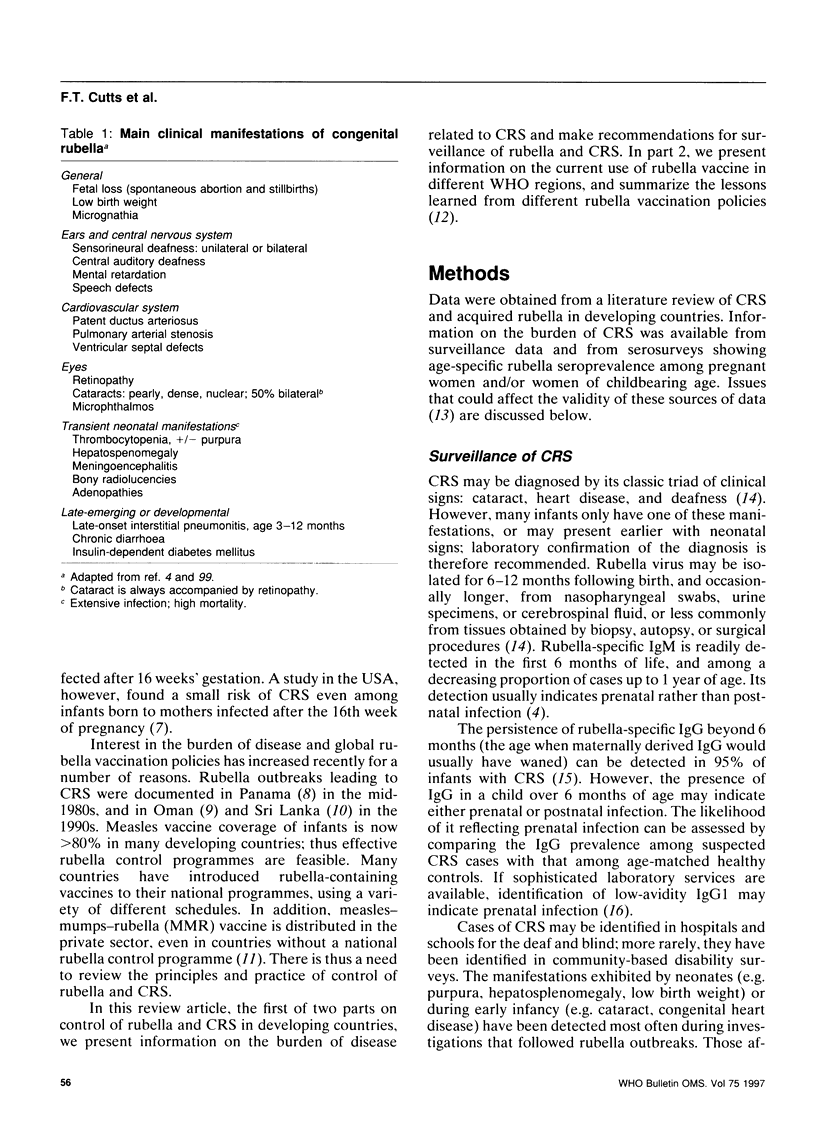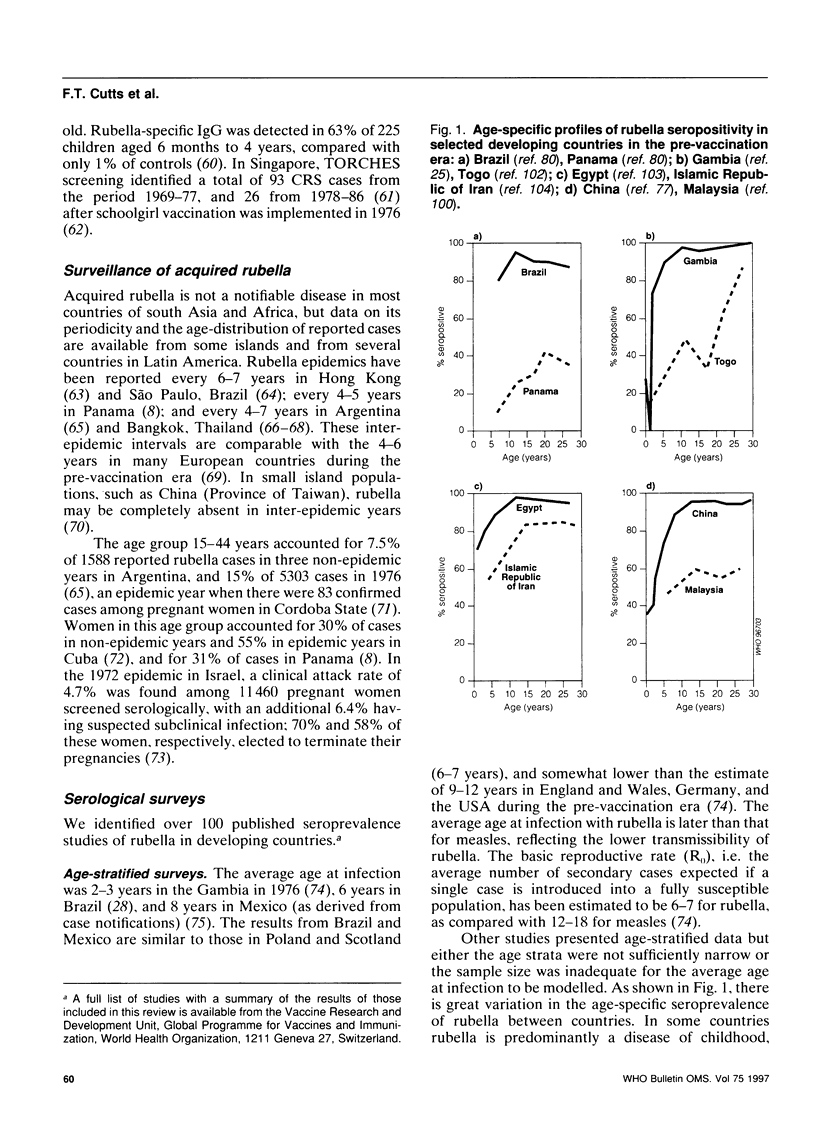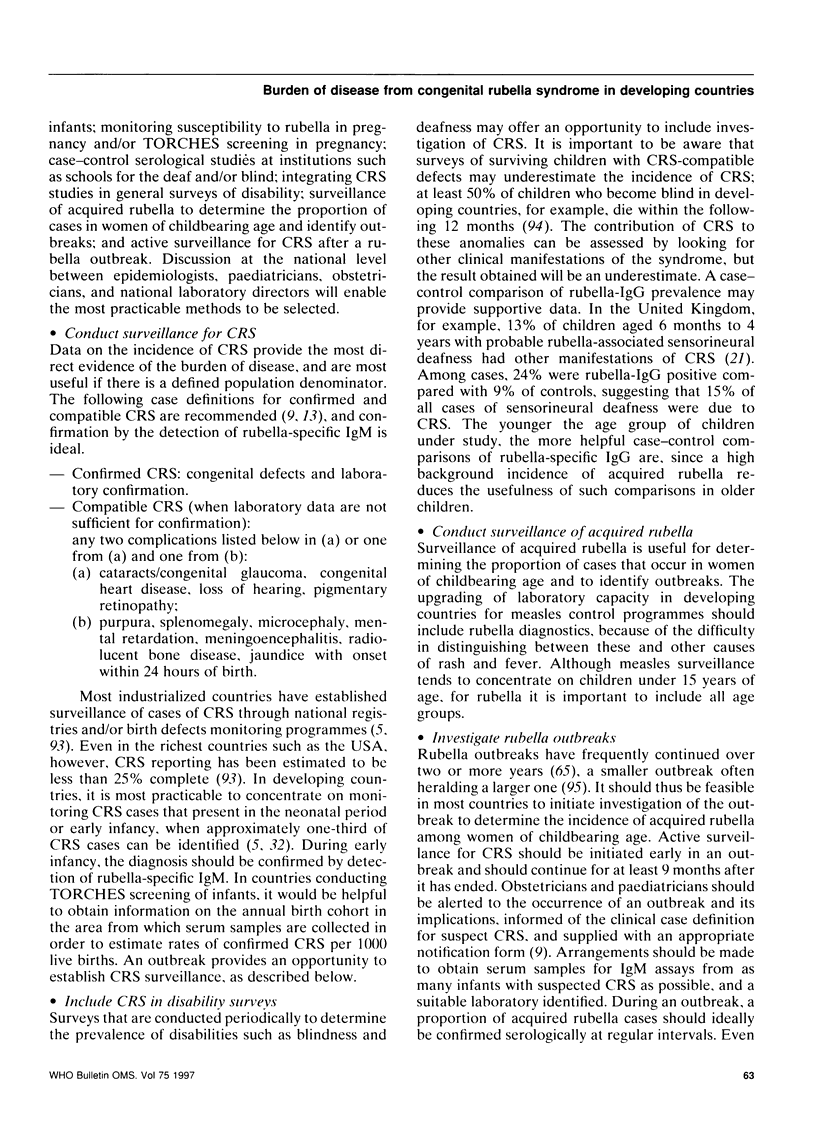Abstract
Congenital rubella syndrome (CRS) can lead to deafness, heart disease, and cataracts, and a variety of other permanent manifestations. In developing countries, the burden of CRS has been assessed as follows: by surveillance of CRS; by surveillance of acquired rubella; by age-stratified serosurveys; and by serosurveys documenting the rubella susceptibility of women of childbearing age. During rubella outbreaks, rates of CRS per 1000 live births were at least 1.7 in Israel, 1.7 in Jamaica, 0.7 in Oman, 2.2 in Panama, 1.5 in Singapore, 0.9 in Sri Lanka, and 0.6 in Trinidad and Tobago. These rates are similar to those reported from industrialized countries during the pre-vaccine era. Special studies of CRS have been reported from all WHO regions. Rubella surveillance data show that epidemics occur every 4-7 years, similar to the situation in Europe during the pre-vaccination era. In developing countries, the estimated average age at infection varies from 2-3 years to 8 years. For 45 developing countries we identified serosurveys of women of childbearing age that had enrolled > or = 100 individuals. The proportion of women who remained susceptible to rubella (e.g. seronegative) was < 10% in 13 countries. 10-24% in 20 countries, and > or = 25% in 12 countries. Discussed are methods to improve the surveillance of rubella and CRS in developing countries.
Full text
PDF













Selected References
These references are in PubMed. This may not be the complete list of references from this article.
- Ali Z., Hull B., Lewis M. Neonatal manifestation of congenital rubella following an outbreak in Trinidad. J Trop Pediatr. 1986 Apr;32(2):79–82. doi: 10.1093/tropej/32.2.79. [DOI] [PubMed] [Google Scholar]
- Anderson R. M., May R. M. Vaccination against rubella and measles: quantitative investigations of different policies. J Hyg (Lond) 1983 Apr;90(2):259–325. doi: 10.1017/s002217240002893x. [DOI] [PMC free article] [PubMed] [Google Scholar]
- Antia A. U. Congenital heart disease in Nigeria. Clinical and necropsy study of 260 cases. Arch Dis Child. 1974 Jan;49(1):36–39. doi: 10.1136/adc.49.1.36. [DOI] [PMC free article] [PubMed] [Google Scholar]
- Baxter D. N. Control of the congenital rubella syndrome in Jamaica. West Indian Med J. 1986 Mar;35(1):50–54. [PubMed] [Google Scholar]
- Black F. L., Berman L. L., Borgoño J. M., Capper R. A., Carvalho A. A., Collins C., Glover O., Hijazi Z., Jacobson D. L., Lee Y. L. Geographic variation in infant loss of maternal measles antibody and in prevalence of rubella antibody. Am J Epidemiol. 1986 Sep;124(3):442–452. doi: 10.1093/oxfordjournals.aje.a114415. [DOI] [PubMed] [Google Scholar]
- Broor S., Kapil A., Kishore J., Seth P. Prevalence of rubella virus and cytomegalovirus infections in suspected cases of congenital infections. Indian J Pediatr. 1991 Jan-Feb;58(1):75–78. doi: 10.1007/BF02810416. [DOI] [PubMed] [Google Scholar]
- Chakrabarty M. S., Das B. C., Gupta B., Sarkar J. K. Rubella as an aetiological factor of congenital malformation in Calcutta--a serological study. Indian J Med Res. 1975 Oct;63(10):1438–1445. [PubMed] [Google Scholar]
- Chaturvedi U. C., Tripathi B. N., Mathur A., Singh U. K., Mehrotra R. M. Role of rubella in congenital malformations in India. J Hyg (Lond) 1976 Feb;76(1):33–40. doi: 10.1017/s0022172400054917. [DOI] [PMC free article] [PubMed] [Google Scholar]
- Clarke M., Schild G. C., Boustred J., McGregor I. A., Williams K. Epidemiological studies of rubella virus in a tropical African community. Bull World Health Organ. 1980;58(6):931–935. [PMC free article] [PubMed] [Google Scholar]
- Cochi S. L., Edmonds L. E., Dyer K., Greaves W. L., Marks J. S., Rovira E. Z., Preblud S. R., Orenstein W. A. Congenital rubella syndrome in the United States, 1970-1985. On the verge of elimination. Am J Epidemiol. 1989 Feb;129(2):349–361. doi: 10.1093/oxfordjournals.aje.a115138. [DOI] [PubMed] [Google Scholar]
- Cohen N., Rahman H., Sprague J., Jalil M. A., Leemhuis de Regt E., Mitra M. Prevalence and determinants of nutritional blindness in Bangladeshi children. World Health Stat Q. 1985;38(3):317–330. [PubMed] [Google Scholar]
- Cradock-Watson J. E. Laboratory diagnosis of rubella: past, present and future. Epidemiol Infect. 1991 Aug;107(1):1–15. doi: 10.1017/s0950268800048639. [DOI] [PMC free article] [PubMed] [Google Scholar]
- Desudchit P., Chatiyanonda K., Bhamornsathit S. Rubella antibody among Thai women of childbearing age. Southeast Asian J Trop Med Public Health. 1978 Sep;9(3):312–316. [PubMed] [Google Scholar]
- Doraisingham S., Goh K. T. The rubella immunity of women of child-bearing age in Singapore. Ann Acad Med Singapore. 1981 Apr;10(2):238–241. [PubMed] [Google Scholar]
- Dowdle W. R., Ferrera W., De Salles Gomes L. F., King D., Kourany M., Madalengoitia J., Pearson E., Swanston W. H., Tosi H. C., Vilches A. M. WHO collaborative study on the sero-epidemiology of rubella in Caribbean and Middle and South American populations in 1968. Bull World Health Organ. 1970;42(3):419–422. [PMC free article] [PubMed] [Google Scholar]
- Dudgeon J. A. Congenital rubella. J Pediatr. 1975 Dec;87(6 Pt 2):1078–1086. doi: 10.1016/s0022-3476(75)80119-3. [DOI] [PubMed] [Google Scholar]
- Eckstein M. B., Brown D. W., Foster A., Richards A. F., Gilbert C. E., Vijayalakshmi P. Congenital rubella in south India: diagnosis using saliva from infants with cataract. BMJ. 1996 Jan 20;312(7024):161–161. doi: 10.1136/bmj.312.7024.161. [DOI] [PMC free article] [PubMed] [Google Scholar]
- Elango S., Reddy T. N., Shriwas S. R. Ocular abnormalities in children from a Malaysian school for the deaf. Ann Trop Paediatr. 1994;14(2):149–152. doi: 10.1080/02724936.1994.11747708. [DOI] [PubMed] [Google Scholar]
- Fall M., Kuakuvi N., Diadhiou F., Martin L. S. Rubéole congénitale (à propos d'un cas observè au C.H.U. de Dakar) Bull Soc Med Afr Noire Lang Fr. 1975;20(4):404–410. [PubMed] [Google Scholar]
- Fogel A., Gerichter C. B., Rannon L., Bernholtz B., Handsher R. Serologic studies in 11,460 pregnant women during the 1972 rubella epidemic in Israel. Am J Epidemiol. 1976 Jan;103(1):51–59. doi: 10.1093/oxfordjournals.aje.a112204. [DOI] [PubMed] [Google Scholar]
- Foster A. Childhood blindness. Eye (Lond) 1988;2 (Suppl):S27–S36. doi: 10.1038/eye.1988.131. [DOI] [PubMed] [Google Scholar]
- Frieden I. J., Resnick S. D. Childhood exanthems. Old and new. Pediatr Clin North Am. 1991 Aug;38(4):859–887. doi: 10.1016/s0031-3955(16)38157-3. [DOI] [PubMed] [Google Scholar]
- Galazka A. Rubella in Europe. Epidemiol Infect. 1991 Aug;107(1):43–54. doi: 10.1017/s0950268800048664. [DOI] [PMC free article] [PubMed] [Google Scholar]
- Gomwalk N. E., Ezeronye O. U. Sero-epidemiology of rubella in Imo State of Nigeria. Trans R Soc Trop Med Hyg. 1985;79(6):777–780. doi: 10.1016/0035-9203(85)90114-2. [DOI] [PubMed] [Google Scholar]
- Gunasekera D. P., Gunasekera P. C. Rubella immunisation-learning from developed countries. Lancet. 1996 Jun 15;347(9016):1694–1695. [PubMed] [Google Scholar]
- Gutíerrez Trujillo G., Muñoz O., Tapia Conyer R., Bustamante Calvillo M. E., Alvarez y Muñoz M. T., Guiscafré Gallardo J. P., Magos C., Sepúlveda J. Seroepidemiología de la rubéola en mujeres mexicanas. Encuesta nacional probabilística. Salud Publica Mex. 1990 Nov-Dec;32(6):623–631. [PubMed] [Google Scholar]
- Hossain A., Bakir T. M., Ramia S. Immune status to congenital infections by TORCH agents in pregnant Saudi women. J Trop Pediatr. 1986 Apr;32(2):83–86. doi: 10.1093/tropej/32.2.83. [DOI] [PubMed] [Google Scholar]
- Intaraprasert S., O-Prasertsawat P., Phiromsawat S. Postpartum rubella immunization: Ramathibodi experience in March-April 1986. J Med Assoc Thai. 1988 Mar;71 (Suppl 1):94–97. [PubMed] [Google Scholar]
- Isacsohn M., Nishmi M., Swartz T. A. Rubella in Jerusalem. 2. Clinical and serologic findings in children with congenital rubella. Isr J Med Sci. 1979 Jan;15(1):17–22. [PubMed] [Google Scholar]
- José M. V., Olvera J., Serrano O. Epidemiología de la rubéola en México. Salud Publica Mex. 1992 May-Jun;34(3):318–327. [PubMed] [Google Scholar]
- Khalifa A. S., Abdel-Wahab K. S., Imam I. Z. Seroimmunity to rubella among an Egyptian population. J Infect Dis. 1973 May;127(5):567–570. doi: 10.1093/infdis/127.5.567. [DOI] [PubMed] [Google Scholar]
- Khare S., Banerjee K., Padubidri V., Rai A., Kumari S., Kumari S. Lowered immunity status of rubella virus infection in pregnant women. J Commun Dis. 1987 Dec;19(4):391–395. [PubMed] [Google Scholar]
- Khare S., Gupta H. L., Banerjee K., Kumari S., Kumari S., Gupta H. L. Seroimmunity to rubella virus infection in young adult females in Delhi. J Commun Dis. 1990 Dec;22(4):279–280. [PubMed] [Google Scholar]
- Kopenhager T., Kort H., Bloch B. An analysis of the first 200 legal abortions at the Johannesburg General Hospital. S Afr Med J. 1978 May 27;53(21):858–860. [PubMed] [Google Scholar]
- LANCASTER H. O. Deafness as an epidemic disease in Australia; a note on census and institutional data. Br Med J. 1951 Dec 15;2(4745):1429–1432. doi: 10.1136/bmj.2.4745.1429. [DOI] [PMC free article] [PubMed] [Google Scholar]
- Lam S. K. The seroepidemiology of rubella in Kuala Lumpur, West Malaysia. Bull World Health Organ. 1972;47(1):127–129. [PMC free article] [PubMed] [Google Scholar]
- Lin D. B., Chen C. J. Current seroepidemiology of rubella virus infection among female residents in Taiwan. J Med Virol. 1993 Oct;41(2):174–178. doi: 10.1002/jmv.1890410215. [DOI] [PubMed] [Google Scholar]
- Manjunath N., Balaya S. Serological study on congenital rubella in Delhi. Indian J Med Res. 1984 Jun;79:716–721. [PubMed] [Google Scholar]
- Marquez A., Zapata M. T. Comportamiento epidemiológico de la rubéola en la provincia de Córdoba, Argentina. Bol Oficina Sanit Panam. 1984 Jul;97(1):14–25. [PubMed] [Google Scholar]
- Marquez A., Zapata M. T. Rubéola y embarazo: control serológico en la determinación de riesgos y daños. Bol Oficina Sanit Panam. 1984 Aug;97(2):95–104. [PubMed] [Google Scholar]
- Maselle S. Y., Haukenes G., Rutahindurwa A. Preliminary observations on rubella infection in Tanzania and the challenge for its control. East Afr Med J. 1988 May;65(5):319–324. [PubMed] [Google Scholar]
- Massad E., Burattini M. N., de Azevedo Neto R. S., Yang H. M., Coutinho F. A., Zanetta D. M. A model-based design of a vaccination strategy against rubella in a non-immunized community of São Paulo State, Brazil. Epidemiol Infect. 1994 Jun;112(3):579–594. doi: 10.1017/s0950268800051281. [DOI] [PMC free article] [PubMed] [Google Scholar]
- Mathur A., Chaturvedi U. C., Mehrotra R. M. Serological study for the prevalence of rubella at Lucknow. Indian J Med Res. 1974 Feb;62(2):307–312. [PubMed] [Google Scholar]
- Mathur A., Tripathi R., Chaturvedi U. C., Mehra P. Congenital rubella following inapparent rubella infection. Indian J Med Res. 1982 Apr;75:469–473. [PubMed] [Google Scholar]
- McPherson B., Holborow C. A. A study of deafness in West Africa: the Gambian Hearing Health Project. Int J Pediatr Otorhinolaryngol. 1985 Nov;10(2):115–135. doi: 10.1016/s0165-5876(85)80024-0. [DOI] [PubMed] [Google Scholar]
- Mendis L. Susceptibility to rubella virus among Sri Lankan women. Ceylon Med J. 1989 Jun;34(2):73–75. [PubMed] [Google Scholar]
- Menser M. A., Hudson J. R., Murphy A. M., Upfold L. J. Epidemiology of congenital rubella and results of rubella vaccination in Australia. Rev Infect Dis. 1985 Mar-Apr;7 (Suppl 1):S37–S41. doi: 10.1093/clinids/7.supplement_1.s37. [DOI] [PubMed] [Google Scholar]
- Miller E., Cradock-Watson J. E., Pollock T. M. Consequences of confirmed maternal rubella at successive stages of pregnancy. Lancet. 1982 Oct 9;2(8302):781–784. doi: 10.1016/s0140-6736(82)92677-0. [DOI] [PubMed] [Google Scholar]
- Moriarty B. J. Childhood blindness in Jamaica. Br J Ophthalmol. 1988 Jan;72(1):65–67. doi: 10.1136/bjo.72.1.65. [DOI] [PMC free article] [PubMed] [Google Scholar]
- Obiako M. N. Profound childhood deafness in Nigeria: a three year survey. Ear Hear. 1987 Apr;8(2):74–77. doi: 10.1097/00003446-198704000-00003. [DOI] [PubMed] [Google Scholar]
- Odelola H. A., Fabiyi A., Familusi J. B. Distribution of rubella antibodies in Nigeria. Trans R Soc Trop Med Hyg. 1977;71(5):425–426. doi: 10.1016/0035-9203(77)90044-x. [DOI] [PubMed] [Google Scholar]
- Odelola H. A. Rubella haemagglutination inhibiting antibodies in females of child-bearing age in western Nigeria. J Hyg Epidemiol Microbiol Immunol. 1978;22(2):190–194. [PubMed] [Google Scholar]
- Ojala P., Vesikari T., Elo O. Rubella during pregnancy as a cause of congenital hearing loss. Am J Epidemiol. 1973 Nov;98(5):395–401. doi: 10.1093/oxfordjournals.aje.a121568. [DOI] [PubMed] [Google Scholar]
- Orenstein W. A., Bart K. J., Hinman A. R., Preblud S. R., Greaves W. L., Doster S. W., Stetler H. C., Sirotkin B. The opportunity and obligation to eliminate rubella from the United States. JAMA. 1984 Apr 20;251(15):1988–1994. [PubMed] [Google Scholar]
- Orenstein W. A., Preblud S. R., Bart K. J., Hinman A. R. Methods of assessing the impact of congenital rubella infection. Rev Infect Dis. 1985 Mar-Apr;7 (Suppl 1):S22–S28. doi: 10.1093/clinids/7.supplement_1.s22. [DOI] [PubMed] [Google Scholar]
- Phiromsawat S., Tongyai T., O-Prasertsawat P., Kanachareon A., Imsoon L., Bhodipala P., Chaturachinda K. Rubella: a serologic study in pregnant women at Ramathibodi Hospital (1984-1985). J Med Assoc Thai. 1988 Jul;71 (Suppl 2):26–28. [PubMed] [Google Scholar]
- Pruksananonda P., Bumrungtrakul P. Serosurvey of rubella antibody among health personnel of Songklanagarind University Hospital, Thailand. Southeast Asian J Trop Med Public Health. 1983 Sep;14(3):380–384. [PubMed] [Google Scholar]
- Rawls W. E., Melnick J. L., Bradstreet C. M., Bailey M., Ferris A. A., Lehmann N. I., Nagler F. P., Furesz J., Kono R., Ohtawara M. WHO collaborative study on the sero-epidemiology of rubella. Bull World Health Organ. 1967;37(1):79–88. [PMC free article] [PubMed] [Google Scholar]
- Saad de Owens C., Tristan de Espino R. Rubella in Panama: still a problem. Pediatr Infect Dis J. 1989 Feb;8(2):110–115. [PubMed] [Google Scholar]
- Sachdeva R. Congenital rubella syndrome at Mombasa. East Afr Med J. 1973 Mar;50(3):146–151. [PubMed] [Google Scholar]
- Schatzmayr H. G. Aspects of rubella infection in Brazil. Rev Infect Dis. 1985 Mar-Apr;7 (Suppl 1):S53–S55. doi: 10.1093/clinids/7.supplement_1.s53. [DOI] [PubMed] [Google Scholar]
- Seth P., Balaya S., Mohapatra L. N. Rubella antibody in pregnant women. Indian J Pathol Bacteriol. 1972 Jan;15(1):23–26. [PubMed] [Google Scholar]
- Seth P., Balaya S., Mohapatra L. N. Sero-epidemiological study of rubella infection in female subjects of Delhi and its surrounding villages. Indian J Med Res. 1971 Feb;59(2):190–194. [PubMed] [Google Scholar]
- Siegel M., Fuerst H. T., Peress N. S. Fetal mortality in maternal rubella. Results of a prospective study from 1957 to 1964. Am J Obstet Gynecol. 1966 Sep 15;96(2):247–253. [PubMed] [Google Scholar]
- South M. A., Sever J. L. Teratogen update: the congenital rubella syndrome. Teratology. 1985 Apr;31(2):297–307. doi: 10.1002/tera.1420310216. [DOI] [PubMed] [Google Scholar]
- Strauss J., Dobahi S. S., Danes L., Kopecký K., Svandová E. Serological survey of rubella in Yemen in 1985. J Hyg Epidemiol Microbiol Immunol. 1989;33(2):163–167. [PubMed] [Google Scholar]
- Stray-Pedersen B. Economic evaluation of different vaccination programmes to prevent congenital rubella. NIPH Ann. 1982 Dec;5(2):69–83. [PubMed] [Google Scholar]
- Swartz T. A., Hornstein L., Epstein I. Epidemiology of rubella and congenital rubella infection in Israel, a country with a selective immunization program. Rev Infect Dis. 1985 Mar-Apr;7 (Suppl 1):S42–S46. doi: 10.1093/clinids/7.supplement_1.s42. [DOI] [PubMed] [Google Scholar]
- Tan D. S. Congenital rubella syndrome in Malaysia. Med J Malaysia. 1985 Mar;40(1):11–14. [PubMed] [Google Scholar]
- Tan K. L. Intra-uterine infections. Ann Acad Med Singapore. 1987 Oct;16(4):707–712. [PubMed] [Google Scholar]
- Tan K. L., Wong T. T., Chan M. C., Chun F. Y., Lam S. K. Congenital rubella in Singapore. J Singapore Paediatr Soc. 1970 Oct;12(2):111–125. [PubMed] [Google Scholar]
- Tantivanich S., Savanat T., Vongsthongsri U., Manesuwan P. Serological studies on possible causes of intra-uterine infections in Thai infants. Southeast Asian J Trop Med Public Health. 1980 Sep;11(3):387–394. [PubMed] [Google Scholar]
- Thomas H. I., Morgan-Capner P., Cradock-Watson J. E., Enders G., Best J. M., O'Shea S. Slow maturation of IgG1 avidity and persistence of specific IgM in congenital rubella: implications for diagnosis and immunopathology. J Med Virol. 1993 Nov;41(3):196–200. doi: 10.1002/jmv.1890410305. [DOI] [PubMed] [Google Scholar]
- Topal B., Kanra G., Ceyhan M. Serological evaluation of 52 children immunized with the combined measles, mumps and rubella vaccine. Turk J Pediatr. 1991 Jan-Mar;33(1):13–18. [PubMed] [Google Scholar]
- Upfold L. J. Changes in the significance of maternal rubella as a factor in childhood deafness--1954 to 1982. Med J Aust. 1984 May 26;140(11):641–644. doi: 10.5694/j.1326-5377.1984.tb108288.x. [DOI] [PubMed] [Google Scholar]


